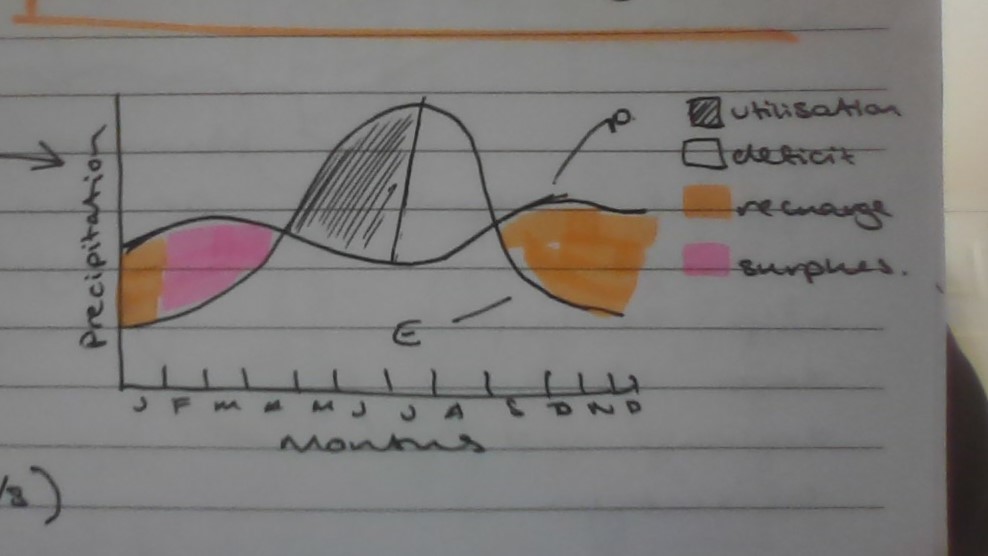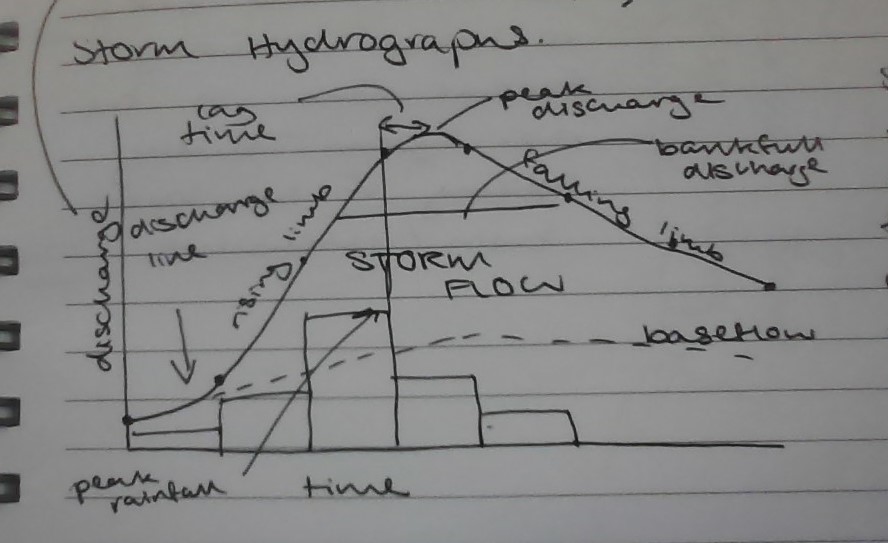Geography A-Level Water & Carbon Cycles: River Exe Case Study
1/20
Name | Mastery | Learn | Test | Matching | Spaced |
|---|
No study sessions yet.
21 Terms
What is the definition water balance in a drainage basin?
The balance between inputs and outputs in the drainage basin system.

What is the equation for water balance?
P=Q+E±(Δs)

What are the key parts of a storm hydrograph?
Discharge line, Rising limb, Bankfull discharge, Peak rainfall, Lag time, Falling limb, Baseflow

What is the difference between a ‘flashy’ and a ‘subdued’ response to a rainfall event on a storm hydrograph?
‘Flashy’ responses have a steep rising limb, lag time between peak rainfall and peak discharge is short, and discharge quickly reaches bankfull, potentially causing flooding. On the other hand, ‘subdued’ responses have a more shallow rising limb with longer lagtime and are slower to return to baseflow.
How can physical features of a drainage basin influence its response to a storm event?
A steep relief can cause faster runoff, and so the response will be more ‘flashy’.
Water may be unable to percolate through the rock if it is low permeability, leading to the soil becoming saturated, which increases runoff and ‘flashiness’.
If agricultural land use is high in the drainage basin, runoff may increase, as grazing animals compact the soil and reduce its permeability, increasing runoff, which causes a ‘flashy’ response.
If woodlands and forests make up a large proportion of the drainage basin, interception and evapotranspiration will increase, causing less runoff and a less ‘flashy’ response to a storm event.
How can human activity impact a drainage basin’s response to a storm event?
Urbanised areas have less soil cover and more impermeable surfaces, this leads to increased runoff and a ‘flashy’ response.
Drainage systems in urbanised areas are able to prevent flooding by redirecting the water to nearby rivers. This increases discharge and causes a ‘flashy’ response, especially further down the river.
Reservoirs and hydroelectric dams can be used to control the flow of water during a storm event. This can lead to a more ‘subdued’ response.
Where is the River Exe located within England?
In the south-west. Its drainage basin spans both Somerset and Devon, and flows through major towns such as Tiverton, Exeter, and Exmouth.
What are the Exe’s three main tributaries?
The Creedy, the Barle, and the Clyst. This high drainage density leads to a ‘flashy’ rainfall event response.
Where are the source and mouth of the river Exe?
The source of the River Exe is in Exmoor National Park, and is the highest point of the Exe at 516m above sea level.
The mouth of the river Exe is at Exmouth, where the river drains into the English Channel.
What influence does the topography of the Exe’s drainage basin have on its response to storm events?
Steep terrain in the upper and middle course of the river leads to flashy responses. The drainage basin is steep for a majority of the river’s trajectory, as the average height of the river above sea level is 171m.
What influence does the geology of the Exe’s drainage basin have on its response to storm events?
Only 2.5% of the rock in the Exe drainage basin is high permeability, and 93.5% of the rock is mid or low permeability, which causes more flashy responses as not all the water can be absorbed by the soil and rock.
What influence does the land use of the Exe’s drainage basin have on its response to storm events?
Only 13% of the land use of the Exe drainage basin is woodland, which reduces interception and increases runoff.
23.5% of the land use is arable land.
57% of the land use is grassland (mostly agricultural) which causes high runoff from soil compacted by grazing cattle.
Only 4.5% of the land use is urban, meaning that the main reason for the Exe’s flashy responses is not urban land use.
Why is the River Exe’s regime so variable?
Because the river has a high drainage density, and its source is on high ground, so relief rainfall also increases the discharge. Summer storms also cause high discharge peaks that break up the river’s seasonal patterns.
How many properties are at risk of flooding in the Exe basin?
11,000 properties with an annual flood risk of 1%. There have been no recent major floods, but risk is still significant.
How does human activity influence the River Exe drainage basin?
On a local scale, Urbanisation has an impact on discharge and storm response in Exeter, the largest settlement on the river Exe.
In the upper catchment of the Exe, drainage ditches dug in the peat bogs on Exmoor by farmers to make the land suitable for grazing led to increased runoff and discharge.
Wimbleball reservoir acts as a giant store of water in the basin which reduces the risk of flooding and provides a sustainable source of water to the populations around it.
What is the Exmoor Mires Project?
A collaborative peatland restoration project spanning 2000 hectares which blocked up drainage ditches on the peatlands in Exmoor in order for them to become saturated again. This prevents droughts and floods by controlling the flow of water, and has a positive impact on the carbon cycle by restoring the peatland, which is a massive carbon sink.
Who collaborated on the Exmoor Mires Project?
Exeter University and Southwest Water both collaborated on the £2.2 million project. The project was also in Southwest Water’s interest, as less drainage ditches leads to water in the system picking up less sediment, which reduces the cost of water treatment.
Name two positive impacts of human activity on the Exe’s drainage basin.
Wimbleball Reservoir
Exmoor Mires Peatland Restoration Project
Name two negative impacts of human activity on the Exe’s drainage basin.
Drainage ditches
Deforestation for grassland grazing
How much water can the restored peatlands from the Exmoor Mires Project hold?
More than 6000 olympic swimming pools of water.
What were the highest and lowest average discharges for the River Exe in 2019?
Highest: 140 cumecs in December
Lowest: 4 cumecs in October